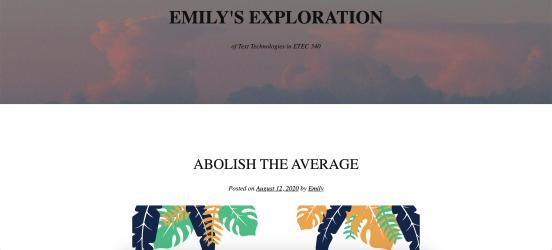I've really enjoyed the blog space approach in this course. Completing a weekly task is only half the fun. The rest comes from browsing through and engaging with other people's posts. The variety in our approaches and thoughts on the same assignment never fails to amaze and intrigue me, and I always close each window with my mind spinning with new ideas. For my linking assignment, I have selected posts that I found myself thinking about long after reading and commenting on them.
Link 6
For my sixth link, I went back to Emily Saundercook’s final research project. The original can be viewed below.
Emily’s posts and ongoing comments have been wonderful. She actually reached out and we had a chat in the middle of this course, playing with the idea of doing a task together, but my schedule didn’t permit it this term. Hopefully our paths will cross in the future and we can get creative together on something!
I selected this because Emily’s project was really well researched and designed. You can see she integrated a variety of information sources, and the piece had real academic integrity, but was written and presented in a way that was not overwhelming or tiresome. The use of both formal and informal content made the piece feel well-rounded and a legitimate open resource on the topic. The aesthetic of the project was also good, integrating logical design elements and flow of information which made the progression of information feel relevant. I didn’t know any of this about the history of averages, and I am really glad that I got the opportunity to engage with the subject matter in this way.
I also have selected her final research project to link to because it gives me such hope for the future of texts, technologies, and education. These hidden aspects to literacy and learning, such as averages, have been involved in the more hidden sides of exclusion in our societies. To see someone bring it together in such a short, but approachable way, is really encouraging. Emily identified the origins of the idea of average, explored thinkers who integrated it into their work and the epistemology behind it, and then linked it to the need to work ever-mode towards an inclusion and diversity model in education. By closing with recommendations of where to identify and work on these matters in education going forward, she rounded up a succinct identification of a problem with practical routes to solutions.
Issues like this are close to my heart, and my ethos in my work as a dual academic and teacher, and it is always really encouraging to see other educators working on these issues as well. This is my last post, and my last assignment, in the MET program and it’s both humbling and invigorating to close with a reflection on a peer’s project that really showcases the type of thinking and the calibre of people that were involved in this program. It’s been a joy to participate, an honour to contribute, and a privilege to learn from others throughout this.
